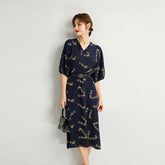When it comes to choosing fabrics that prioritize skin health, silk stands unparalleled. Its unique properties make it a game-changer for sensitive skin, acne-prone complexions, and anyone looking to reduce signs of aging. Here’s why silk deserves a place in your wardrobe—and on your skin.

Silk is a protein-based fiber derived from silkworm cocoons, free from harsh chemicals and synthetic irritants. Unlike cotton or polyester, it doesn’t trap dust mites, mold, or pet dander, making it ideal for allergy sufferers . This natural resistance to allergens helps minimize skin inflammation, itching, and redness—common issues for those with eczema or psoriasis.
Silk’s smooth surface has a friction coefficient of just 0.35 —significantly lower than cotton (0.62) or linen (0.71). This means your skin glides effortlessly over silk, reducing the tugging and folding that cause sleep lines and premature wrinkles. For side sleepers, silk minimizes pressure on facial muscles, helping maintain skin elasticity over time.
Silk’s hygroscopic nature allows it to absorb up to 30% of its weight in moisture without feeling damp. This dual action—absorbing sweat while releasing excess humidity—keeps skin balanced. For acne-prone individuals, silk helps regulate sebum production, preventing clogged pores and breakouts.
Silk contains sericin, a natural protein with antimicrobial properties that
inhigbit bacterial growth. This makes
silk bedding and clothing particularly beneficial for those prone to acne or fungal infections. Additionally, sericin’s antioxidant effects neutralize free radicals, protecting skin from environmental damage.
Silk’s dense weave and amino acids act as a natural sunscreen, absorbing harmful UV rays. While it’s not a substitute for SPF,
silk clothing provides an extra layer of defense against sun damage, helping prevent hyperpigmentation and skin cancer
Modern silk production prioritizes eco-friendly practices, such as peace silk (allowing silkworms to hatch before harvesting cocoons) and regenerative farming.
-
Momme Weight: Look for 19 momme or higher for durability and comfort.
-
Certifications: OEKO-TEX® Standard 100 ensures no harmful chemicals.
-
Care Tips: Hand-wash in gentle detergent, air-dry, and store in breathable fabric bags to preserve silk’s benefits.
Silk isn’t just a luxury—it’s a health investment. Its hypoallergenic, anti-aging, and moisture-regulating properties make it the ultimate fabric for skin wellness. Whether you’re updating your wardrobe or upgrading your bedding, silk’s science-backed benefits will leave your skin glowing.






